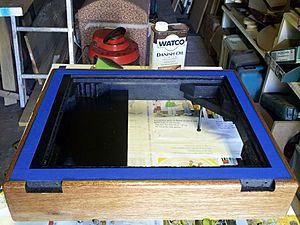Danish oil facts for kids
Danish oil is a special type of wood finishing oil. It's often made from natural oils like tung oil or linseed oil. Because there isn't one exact recipe, what's inside Danish oil can be a bit different depending on who makes it.
Danish oil is a "drying oil." This means it can turn solid when it touches the air. It creates a strong, often waterproof, finish on wood that isn't too shiny. Think of it like a protective shield for wood! It can also be used as a first coat on bare wood before you paint or varnish it. It's usually a mix of oil and varnish.
How is Danish Oil Used?
When you put Danish oil on wood, it dries into a tough, smooth finish. This finish is good at resisting liquids. Since the finished wood isn't super shiny or slippery, Danish oil is great for things like kitchen tools or tool handles. It helps protect them from water and can also make the wood look a bit darker. You can even find special types that add color to the wood if you want to stain it.
How to Apply Danish Oil
Applying Danish oil is quite easy, especially compared to varnish. You usually put on three coats. You can use a brush or a cloth. After you apply it, you wipe off any extra oil shortly after. You then let the finish dry for about 4 to 24 hours between coats. The drying time depends on the specific oil mix and the type of wood. A small amount of Danish oil can cover a large area, about 12.5 square meters per liter.
Safety Tips for Danish Oil
Rags used with Danish oil, just like those used with linseed oil, can sometimes get very hot on their own. This can cause a fire if they are not handled carefully. To be safe, it's best to dry these rags flat in the open air before throwing them away. Another good idea is to soak them in water before you dispose of them. This helps prevent any chance of a fire starting.


